Oceans
An ocean is a vast body of saltwater that covers almost three-quarters of the Earth's surface. There are five main oceans: the Atlantic, Pacific, Indian, Southern (or Antarctic), and Arctic. Oceans play a crucial role in regulating the Earth's climate, providing a habitat for a wide variety of marine organisms, and serving as a source of food and resources for human beings.
Key Concepts
- Ocean Zones: Oceans are divided into different zones based on their depth and distance from the shore. These zones include the intertidal zone, neritic zone, oceanic zone, and benthic zone.
- Marine Life: Oceans are home to an incredible diversity of marine life, including fish, mammals, invertebrates, and microorganisms. The unique ecosystems within the oceans support a complex food web and play a crucial role in the global carbon cycle.
- Ocean Currents: Ocean currents are large-scale movements of seawater that play a key role in redistributing heat around the Earth. They influence climate patterns, weather systems, and the distribution of nutrients in the ocean.
- Human Impact: Human activities, such as pollution, overfishing, and climate change, have a significant impact on the health of the world's oceans. Understanding these impacts is crucial for the conservation and sustainable management of ocean resources.
Study Guide
Here are some key questions and activities to help you learn more about oceans:
- What are the five main oceans, and where are they located?
- Research and create a visual presentation about a specific marine organism, describing its habitat, behavior, and ecological role.
- Draw and label a diagram of the ocean zones, explaining the unique characteristics of each zone.
- Investigate the causes and effects of ocean pollution, and propose solutions for reducing human impact on the oceans.
- Explore the role of oceans in regulating the Earth's climate and weather patterns, and discuss the potential consequences of climate change on marine ecosystems.
By exploring these key concepts and engaging in the suggested activities, you can develop a deeper understanding of the importance of oceans and the need to protect these vital ecosystems.
.◂Science Worksheets and Study Guides Second Grade. Water Habitats
Study Guide Water Habitats
Water Habitats  Activity Lesson
Activity Lesson Water Habitats
Water Habitats  Worksheet/Answer key
Worksheet/Answer key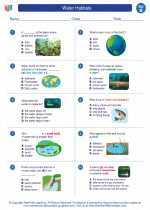 Water Habitats
Water Habitats  Worksheet/Answer key
Worksheet/Answer key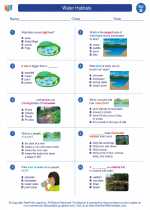 Water Habitats
Water Habitats  Worksheet/Answer key
Worksheet/Answer key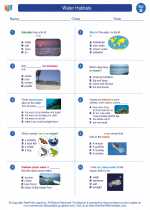 Water Habitats
Water Habitats  Worksheet/Answer key
Worksheet/Answer key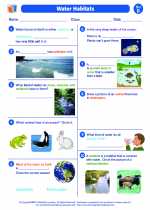 Water Habitats
Water Habitats  Vocabulary/Answer key
Vocabulary/Answer key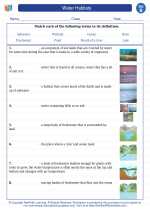 Water Habitats
Water Habitats  Vocabulary/Answer key
Vocabulary/Answer key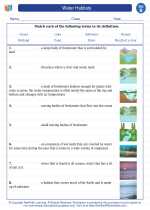 Water Habitats
Water Habitats 

 Activity Lesson
Activity Lesson
 Worksheet/Answer key
Worksheet/Answer key
 Worksheet/Answer key
Worksheet/Answer key
 Worksheet/Answer key
Worksheet/Answer key
 Worksheet/Answer key
Worksheet/Answer key
 Vocabulary/Answer key
Vocabulary/Answer key
 Vocabulary/Answer key
Vocabulary/Answer key

The resources above cover the following skills:
LIFE SCIENCE (NGSS)
Biological Evolution: Unity and Diversity
Students who demonstrate understanding can:
Make observations of plants and animals to compare the diversity of life in different habitats[Clarification Statement: Emphasis is on the diversity of living things in each of a variety of different habitats.] [Assessment Boundary: Assessment does not include specific animal and plant names in specific habitats.]